
Hands On Review: Chapman Brewing Equipment SteelTank Fermenter + Kettle
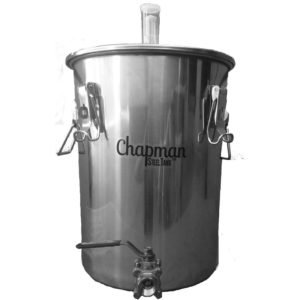
About Chapman SteelTank Fermenters
Chapman Brewing Equipment’s SteelTank line of stainless steel fermenters are available in 7 and 14 gallon sizes in both ported and unported versions. The SteelTank features stainless steel construction, gasketed lid, pressed volume markers and an available port option. The fermenters offer advantages over buckets and glass carboys since they resist breaking and scratching.
Compare Pricing and Models
- Chapman Brewing Equipment 7 Gallon Stainless Steel UniVessel Brew Fermenter Ported affiliate link, note that multiple variations of this product may be available, as such a different version may appear at this link
- Chapman Brewing Equipment ST07NP Stainless Steel Fermenter, 18.2 x 15.4 x 15.1 inches affiliate link, note that multiple variations of this product may be available, as such a different version may appear at this link
- 14 Gallon Stainless Steel Fermenter affiliate link, note that multiple variations of this product may be available, as such a different version may appear at this link
- Search Amazon for “Chapman Brewing Equipment” – offerings vary
- 7 gallon UniVessel Ported Stainless Steel Fermenter via Adventures in Homebrewing
What is a UniVessel?
A UniVessel is a single vessel that accomplishes multiple tasks. There are two primary types of UniVessels in homebrewing. A fermenter that also acts as a serving keg. Examples: FermZilla with a pressure kit and WilliamsWarn BrewKeg. The second type of UniVessel is a boil kettle that also acts as a fermenter. Chapman SteelTanks are Boil Kettle/Fermenter types of UniVessels.
Hands on Review Chapman Brewing Equipment SteelTank Fermenter
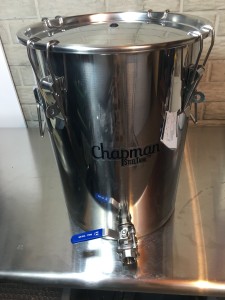 A look at the fully assembled 7 gallon fermenter. Dimensions from Chapman Equipment are… 12″ inner diameter, 16″ height. 14″ diameter at widest point and 20″ height (including ball valve and airlock), Note that this is billed as a This is a UniVessel because it can double as a kettle. You can boil and ferment in the same vessel.
A look at the fully assembled 7 gallon fermenter. Dimensions from Chapman Equipment are… 12″ inner diameter, 16″ height. 14″ diameter at widest point and 20″ height (including ball valve and airlock), Note that this is billed as a This is a UniVessel because it can double as a kettle. You can boil and ferment in the same vessel.
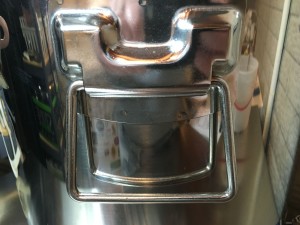 A look at the handle. It is well made, a good size and integrates nicely.
A look at the handle. It is well made, a good size and integrates nicely.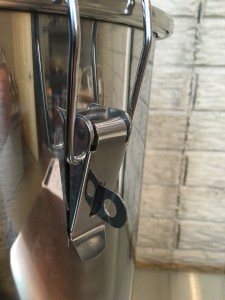 One of the four lid clasps. These move smoothly and seal firmly. These along with the lid seal provide a nice airtight seal. At the price and considering it’s features, I will say that I am impressed by the quality of construction. The smoothness that these operate and solidly clamp into place is an indicator of quality.
One of the four lid clasps. These move smoothly and seal firmly. These along with the lid seal provide a nice airtight seal. At the price and considering it’s features, I will say that I am impressed by the quality of construction. The smoothness that these operate and solidly clamp into place is an indicator of quality.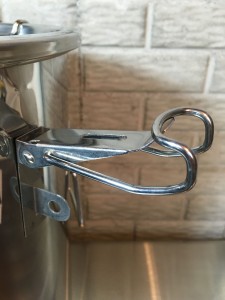 Folded down clasp
Folded down clasp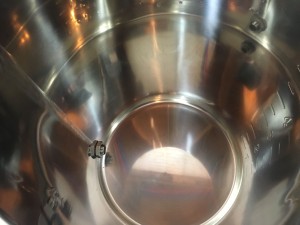 Inside of the 7 gallon fermenter. You can see the inside portion of the removable bulkhead on the left.
Inside of the 7 gallon fermenter. You can see the inside portion of the removable bulkhead on the left.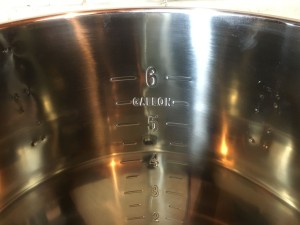 Pressed volume markings are visible inside the fermenter. This is a great feature. Dialing in your recipe, gravities and taste profile are dependent upon getting the right volume of beer. These pressed markers help with that. This is a 7 gallon capacity fermenter which is great for 5 gallon batches. The 14 gallon size should easily accommodate 10 gallon batches.
Pressed volume markings are visible inside the fermenter. This is a great feature. Dialing in your recipe, gravities and taste profile are dependent upon getting the right volume of beer. These pressed markers help with that. This is a 7 gallon capacity fermenter which is great for 5 gallon batches. The 14 gallon size should easily accommodate 10 gallon batches.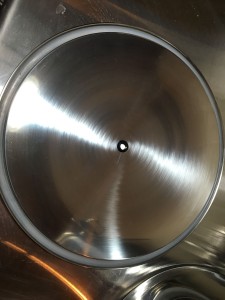 Inside of the lid. Notice the lid o-ring as well as the airlock grommet.
Inside of the lid. Notice the lid o-ring as well as the airlock grommet.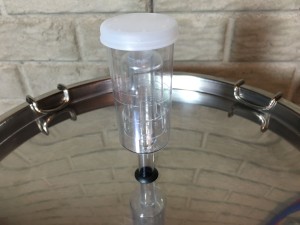 Airlock installed
Airlock installed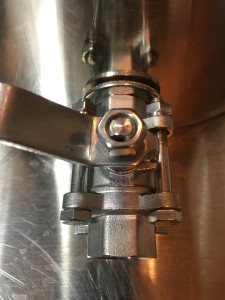 The 3-piece stainless steel ball valve included on ported models can be disassembled for cleaning and sanitation. The instructions recommend removing the ball valve each time before using and boiling for 5 minutes. In addition, you can periodically disassemble to clean and sanitize.
The 3-piece stainless steel ball valve included on ported models can be disassembled for cleaning and sanitation. The instructions recommend removing the ball valve each time before using and boiling for 5 minutes. In addition, you can periodically disassemble to clean and sanitize.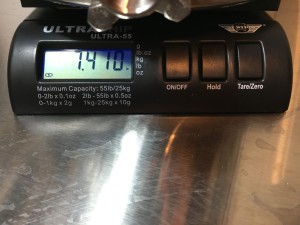 My UltraShip Ultra-55 shows this weighing 7.41 lbs.
My UltraShip Ultra-55 shows this weighing 7.41 lbs.
Conclusions
Considering the build quality, generally great price and well thought out features, this is a great fermenter. The stainless steel design gets you out of plastic and the ported versions allow you to transfer without a siphon. Chapman’s SteelTank Fermenter is thoughtfully designed and well made.
Compare Pricing and Models
- Chapman Brewing Equipment 7 Gallon Stainless Steel UniVessel Brew Fermenter Ported affiliate link, note that multiple variations of this product may be available, as such a different version may appear at this link
- Chapman Brewing Equipment ST07NP Stainless Steel Fermenter, 18.2 x 15.4 x 15.1 inches affiliate link, note that multiple variations of this product may be available, as such a different version may appear at this link
- 14 Gallon Stainless Steel Fermenter affiliate link, note that multiple variations of this product may be available, as such a different version may appear at this link
- Search Amazon for “Chapman Brewing Equipment” – offerings vary
- 7 gallon UniVessel Ported Stainless Steel Fermenter via Adventures in Homebrewing
Related Review: Hands on Review: Chapman Thermobarrel Stainless Steel Mash Tun
Note: This review features a v1 SteelTank Fermenter. Since it was released Chapman has updated and improved these fermenters. General concepts should still apply back there may be some variations.
More Homebrew Finds!
- Last 50 Finds!
- Top Deals – a curated list of the best deals
- Homebrew Reviews – one of the largest libraries of homebrew reviews in existence!
- Our Top Posts – tips, how-tos, resources posts and more
More Fermenter Reviews!
Most Recent Deals
More Fermentation Related!
pinned
This post may contain affiliate links. We may make a commission when you use our links. This will never cost you extra. Thank you for supporting Homebrew Finds!
greatdealsSpecial Thanks to Chapman Brewing Equipment for providing the unit used for evaluation in this review.
Price, promotions and availability can change quickly. Check the product page for current price, description and availability.
Make sure the components you use are compatible and rated for your intended application. Contact manufacturer with questions about suitability or a specific application. Always read and follow manufacturer directions. review:chapmansteeltank tag:tpr


I have 4 of these fermenters, 2 with ports, and 2 without. Both of the ported fermenters have been leaky from the start. From my observation is that they drilled the port hole through the welded seam in the side of the bucket so the o-ring in the weldleess fitting doesn’t seal completely. I tried multiple fittings, valves, and I-rings trying to resolve this issue. Finally I took an auto body hammer to them and flattened the seam around the port. This worked on one of the fermenters but one still leaks.
I also found that the small air lock o-ring in the lid failed immediately so I drilled out the hole with a step bit and use a rubber plug. I believe the newer fermenters now come with this instead of the o-ring.
I did contact the manufacture about the leaking valve issue and was told I didn’t know how to properly install a weld less fitting. I have been brewing for over 10 years and have 12 weld less fittings in many different pieces of brewing equipment and none of them leak. Customer service is definitely lacking a bit.
Despite my issues I do believe Chapman fermenters are the best bargain for the money. The second 2 fermenters I purchased were without ports and they work properly and clean up easily. I am planning to add more of these to my collection in the future.
Hope this helps clear up some questions.
Just wondering- What is it about the Chapman’s ball valve that makes it not “conducive to bottling or gravity transfer?” I thought gravity transfer is what it’s there for. Seems like the unit could be used as an easily sanitized bottling bucket too, unless there really is something about the valve that makes it unsuitable for bottling.
so do you do the boil in this, and then go straight to ferment after coldbreak, or would you still have to do the boil in another vessel and transfer>
I have never boiled in mine, but you it can be used as a kettle. Personally, if I did that, I would use it as a true univessal and boil, chill and ferment in the same vessel. I know you’d have more trub that way, but I think the benefits of skipping the transfer outweigh the trub.
Mike or whomever,
I just bought two of these and racked my first 5 gallon batch into one fermenter last night. My question to you is, did you rack into a secondary? If the beer is clear and the ball valve sits above the trub, I won’t use a secondary. What’s your experience?
Matt,
Hopefully this will answer your questions.
With about 30 batches under my belt now, mostly Belgian styles but not exclusively, the number of times I felt I absolutely HAD to transfer to a secondary were pretty low. Only twice, with really high gravity beers that generated a lot of trub and yeast, did I need to do it to avoid sucking yeast into my bottles at bottling time. A couple of other times I did it because I planned to let the beer condition for 6+ weeks past fermentation and I wanted to get it off as much of the yeast as I could, to avoid off-flavors from autolysis.
In most of the remaining cases, I’ve not bothered with a secondary and I’ve been unable to tell a difference. If I transfer out of the primary at all, it’s usually at bottling time, so I can mix the beer with priming sugar and perhaps some bottle conditioning yeast. (The bottle conditioning yeast will help make sure high-gravity styles carbonate properly – sometimes you wear out the yeast and they won’t carbonate.)
The rubber washer on the chapman’s lid that the airlock sits in is flimsy. My one broke recently (bought in Dec 2015). I am planning on borrowing a step drill to make the hole large enough for a rubber stopper.
The ball valve/gasket setup is somewhat flimsy too…it leaks sometimes, I find.
Other than that, they’re great. I got 2 for $240 or so and have really liked using them over glass.
Because the stainless is fairly thin, it’s easy to alter these to your liking.
I am buying a used speidel fermentor this weekend. It’ll be interesting to see how they compare.
Is this pot induction ready? If so I am pulling the trigger!
Is the port basically a weldless port? Or did they solder it in place? Looks like a great buy, I wish I had the space!
Yes it is a weldless port, which I think is a good call for cleaning and sanitation purposes.
I disagree. I don’t ever want to see threaded fittings anywhere post boil. Threads, especially internal/female pipe thread are nearly impossible to clean and have no place in fermentation.
I get what you’re saying. My point is, considering that this does have threads, I think it’s good they come completely out for cleaning, sanitizing and boiling as needed. I have talked to Steve about the use of a ball valve and such and it is done to keep costs down. As it’s designed now, it’s a matter of disassembling and boiling each time.
I’m thinking this would be a great secondary for dry hopping. Put a screen on the port intake and keep most of the hops in the fermenter. Might have to get one … or two.
I’d be interested on an update once you brew and ferment in it, namely what volume level the valve is at (how much volume is left inside) AND with standard yeast if you get clear beer without much hassle.